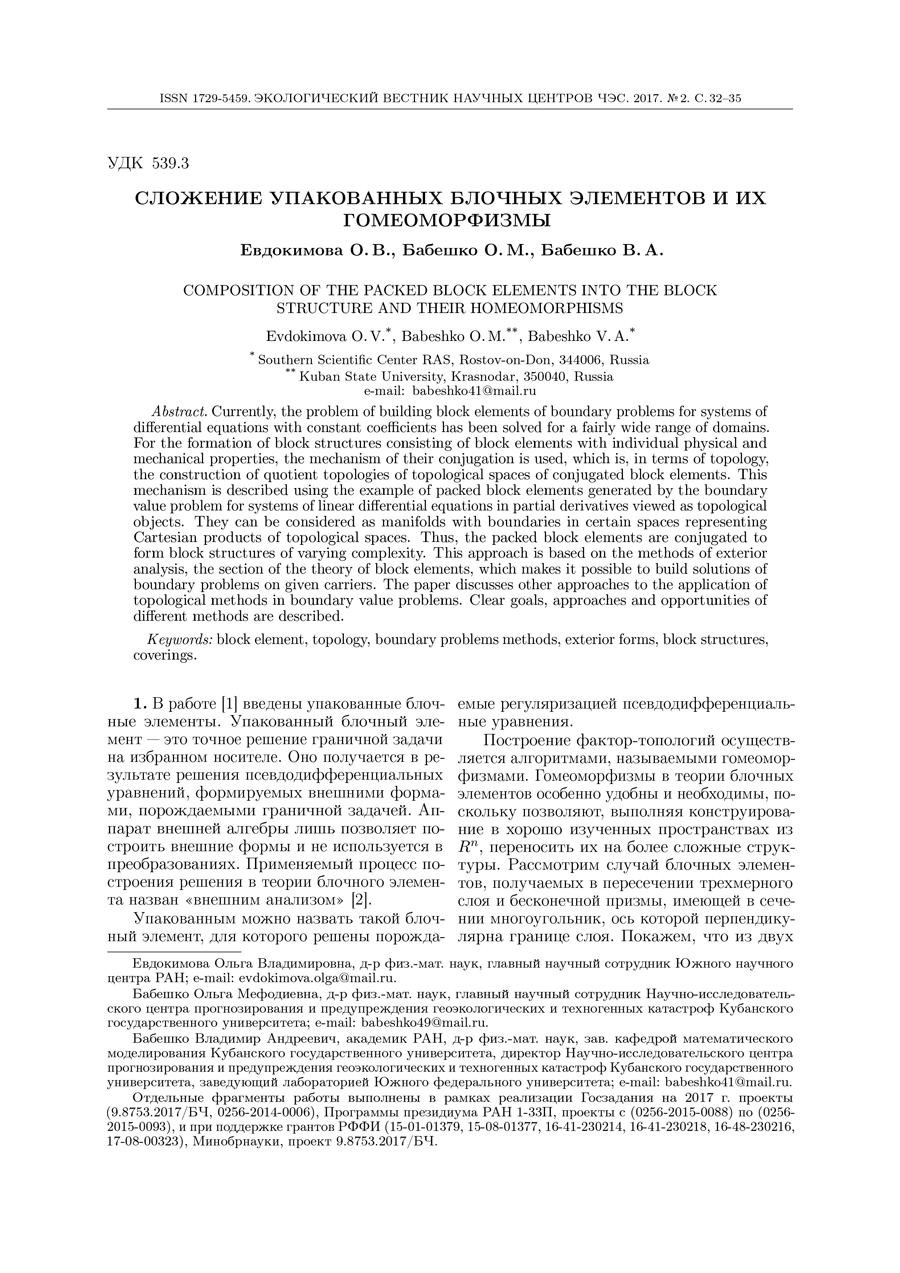Composition of the packed block elements into the block structure and their homeomorphisms
UDC
539.3Abstract
Currently, the problem of building block elements of boundary problems for systems of differential equations with constant coefficients has been solved for a fairly wide range of domains. For the formation of block structures consisting of block elements with individual physical and mechanical properties, the mechanism of their conjugation is used, which is, in terms of topology, the construction of quotient topologies of topological spaces of conjugated block elements. This mechanism is described using the example of packed block elements generated by the boundary value problem for systems of linear differential equations in partial derivatives viewed as topological objects. They can be considered as manifolds with boundaries in certain spaces representing Cartesian products of topological spaces. Thus, the packed block elements are conjugated to form block structures of varying complexity. This approach is based on the methods of exterior analysis, the section of the theory of block elements, which makes it possible to build solutions of boundary problems on given carriers. The paper discusses other approaches to the application of topological methods in boundary value problems. Clear goals, approaches and opportunities of different methods are described.
Keywords:
block element, topology, boundary problems methods, exterior forms, block structures, coveringsAcknowledgement
References
- Babeshko V.A., Evdokimova O.V., Babeshko O.M. O stadiyakh preobrazovaniya blochnykh elementov [On the stages of transformation of block elements]. Doklady Akademii nauk [Rep. of the Academy of Sciences], 2016, vol. 468, no. 2, pp. 154-158. (In Russian)
- Babeshko V.A., Evdokimova O.V., Babeshko O.M. Vneshniy analiz v probleme skrytykh defektov i prognoze zemletryaseniy [External analysis in the problem of hidden defects and the forecast of earthquakes]. Ekologicheskiy vestnik nauchnykh tsentrov Chernomorskogo ekonomicheskogo sotrudnichestva [Ecological bulletin of scientific centers of the Black Sea Economic Cooperation], 2016, no. 2, pp. 19-28. (In Russian)
- Zorich V.A. Matematicheskiy analiz. Chast' 2 [Mathematical analysis. Pt. 2]. Moscow, MTsNMO Pub., 2002, 788 p. (In Russian)
- Kelli D. Obshchaya topologiya [General Topology]. Moscow, Nauka Pub., 1968, 384 p. (In Russian)
- Mishchenko A.S., Fomenko A.T. Kratkiy kurs differentsial'noy geometrii i topologii [A short course of differential geometry and topology]. Moscow, Fizmatlit Pub., 2004, 302 p. (In Russian)
- Golovanov N.N., Il'yutko D.P., Nosovskiy G.V., Fomenko A.T. Komp'yuternaya geometriya [Computer geometry]. Moscow, Akademiya Pub., 2006, 512 p. (In Russian)
- Hassani B., Hinton E. A review of homogenization and topology optimization I - homogenization theory for media with periodic structure. Computers and Structure, 1998, vol. 69, pp. 707-717.
- Hassani B., Hinton E. A review of homogenization and topology optimization II - homogenization theory for media with periodic structure. Computers and Structure, 1998, vol. 69, pp. 719-738.
- Hassani B., Hinton E. A review of homogenization and topology optimization III - homogenization theory for media with periodic structure. Computers and Structure, 1998, vol. 69, pp. 739-756.
- Xin Z.Q., Wu C.J. Topology Optimization of the Caudal Fin of Thtree-Dimantional Self-Propelled Swimming Fish. Adv. Appl. Math. Mech., 2014, vol. 6, iss. 6, pp. 732-763.
- Bendsoe M.P., Sigmund O. Topology Optimization - Theory, Methods and Applications. Berlin, Springer, 2003.
- Bonvall T., Petersson J. Topology optimization of fluids in stokes flow. Int. J. for Numerical Methods in Fluids, vol. 42, pp. 77-107.
- Wachspress E.L. A Rational Finite Element Basis, New York, Academic Press, 1975.
- El-Sabbage A., Baz A. Topology optimization of unconstrained damping treatments for plates. Engineering Optimization, 2013. Vol. 49. P. 1153-1168.
- Zheng W., Lei Y., Li S. et. al. Topology optimization of passive constrained layer damping with partial coverage on plate. J. Shock and Vibration, 2013, vol. 20, pp. 199-211.
- Van der Veen G., Langelaar M., van Keulen F. Integrated topology and controller optimization of motion systems in the frequency domain. Structural and Multidisciplinary Optimization, 2014, vol. 51, pp. 673-685.
- Dahl J.J., Jensen S., Sigmund O. Topology optimization for transient wave propagation problems in one dimension. Structural and Multidisciplinary Optimization, 2008, vol. 36, pp. 585-595.
Downloads
Issue
Pages
Submitted
Published
How to Cite
Copyright (c) 2017 Evdokimova O.V., Babeshko O.M., Babeshko V.A.

This work is licensed under a Creative Commons Attribution 4.0 International License.




